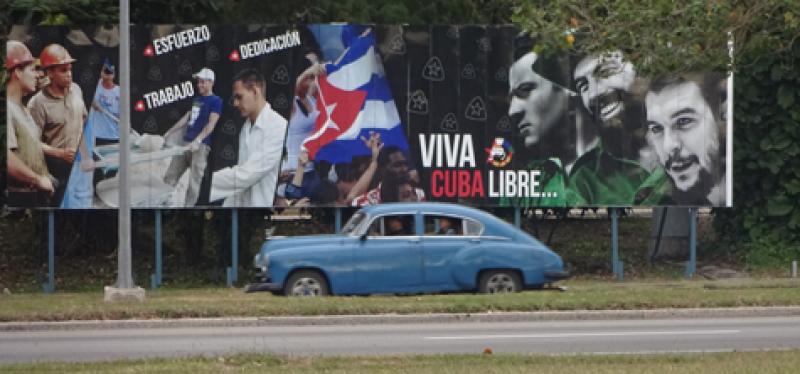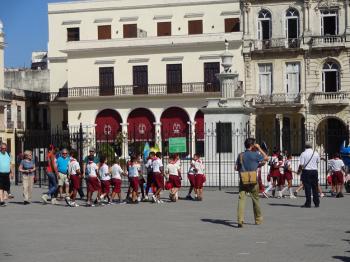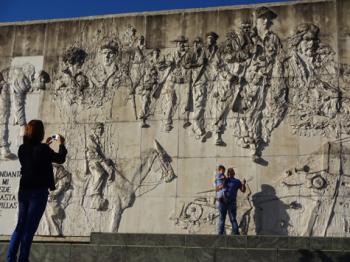Suggestions for filling some free time in Cuba
This article appears on page 44 of the January 2017 issue.
Traveling with two friends, I took a one-week Road Scholar trip in February 2016 to Cuba, where our group of 20 visited Havana and Santa Clara, the latter in the center of the island, and Cienfuegos and Trinidad, both on the southern coast. Because more Americans are getting ready to visit the island since the US lifted several restrictions, I wanted to offer suggestions for those visitors who find themselves with time on their own.
Getting around
In Havana, the older guys in our group salivated over the tricked-out classic cars. You can hire a car for a tour of Havana or just pay for a ride somewhere in the city. The doorman at your hotel should be able to hail a nice one for you and help negotiate a price or tell you what the going rate is for whatever you plan to do.
You’ll find classic-car taxis parked at all major hotels as well as at the Plaza de la Revolución and on the northern edge of Old Town. Be sure to negotiate the price up front. A 15-minute ride to a restaurant cost us $15, and we arranged to be picked up two hours later for the return ride for the same price.
Be aware that there are also cheap classic-car taxis with no amenities, including no stuffing left in the seats!
If you get the urge to try one of the ubiquitous “coco taxis” — little round, yellow 2-seaters — don’t go for a long ride. Their shock absorbers are minimal to nonexistent.
In Cuba, there are two forms of currency: the CUP and the CUC. The CUP, or Cuban peso, is what Cubans receive with a government salary and what they regularly use to shop. The CUC, or “kook,” is the convertible peso that you receive when you exchange foreign currency. The exchange rate is about CUP25 to CUC1.
Since the classic-car rides are priced in CUCs, euros or dollars and it can easily cost the equivalent of one month’s salary for a Cuban ($20-$30) for a ride across town, taxi drivers are the new aristocrats of Cuba, and many medical and other professionals moonlight as drivers.
What to see
Even for those who don’t fancy cemeteries, a visit to Havana’s Cementerio de Colón is worthwhile. Thousands of elaborately carved monuments and mausoleums crowd this 19th-century cemetery in the Vedado neighborhood.
If you don’t go with a guide, ask someone about the grave of “La Milagrosa.” Pregnant women and women wanting to become mothers visit this grave of a mother and her child for blessings. The story told is that the child, who died in childbirth with its mother, was buried at its mother’s feet, but when the coffin later had to be opened, the baby was found in the mother’s arms.
Another worthwhile stop in Havana is the National Museum of Fine Arts, with a collection of Cuban art from the 19th century to the present day. It was interesting to see the influence of European styles on the early Cuban painters.
The museum is across the street from the Granma Memorial, which displays the boat used by Fidel Castro and his partisans to sail from Mexico and begin the revolution in 1956.
I loved the city’s historic Hotel Nacional, which, at the time of our visit, was being spruced up for Barack Obama’s March visit. We sat on the gigantic lawn overlooking the Malecón and Havana Bay and drank mojitos.
However, the best mojitos (with the best bartender performance) were made at the hotel’s Salon de la Historia, worth a visit for its photos of famous guests stretching back to the 1930s.
The cigar shop in the basement of the hotel had the freshest and most varied stock of cigars. Although some places sell them for much less, they’re usually stale. At the Nacional, we were told, it is not unusual to watch someone making a $1,000 purchase of cigars.
Dining dos and don’ts
There are hundreds of new paladares, or private restaurants, in Havana, which range from people’s living rooms, where meals are served, to entire homes renovated into 3-star restaurant spaces. Almost all of them get good reviews on the Yelp and TripAdvisor websites, even if there are only a few reviewers for each. You can do your research or ask your taxi driver for a recommendation.
If you want to eat at one of the well-known and popular places, like Doña Eutimia near the cathedral, make reservations well in advance. We tried to stop there for lunch one day and were told their first open reservation was for 9 p.m. two days later.
Do not try to hurry lunch. We were forewarned that lunches can be a 2-hour affair and service is sometimes very slow. If you’re starving, ask for something to tide you over until your food arrives.
There are also restaurants (that cater to tour groups) that serve full meals very quickly, and some of them are quite decent. Most of our meals were with our group.
Privately, we ate at Esto no es un Café, also near the cathedral, for lunch and at Atelier for dinner. Both were good.
Our simple lunch took 1½ hours, and that was after we told them we had an appointment to keep. We barely had time to make it back to where the other Road Scholars were gathering.
The taxi driver taking us to Atelier warned us of its high prices and offered to take us somewhere just as good and not as expensive, but the people I was traveling with had their hearts set on Atelier. It turned out to be as good as the reviews said it was, and, with drinks and the highest-priced items on the menu, our meal came to about $50 each.
One of the signature meals in Cuba is lobster, and I had some of the best and sweetest lobster I’ve ever tasted in restaurants throughout Cuba.
Beyond Havana
Leaving Havana, our group traveled inland to Santa Clara, where we were to spend the remainder of the week. From there, we took day trips to the southern coastal towns of Playa Larga, Cienfuegos and Trinidad. We were staying more than an hour’s drive from where we wanted to be because that’s what the Cuban tourist office said was available for a group of 20.
While Havana has developed much of the infrastructure needed to cater to travelers, other cities in Cuba have not caught up. The shortage of large hotels outside Havana and the resort cities has been met by families converting their homes to casa particulars, and you can see signs with a symbol that looks like an upside-down blue anchor or a capital “I” that indicate that they offer lodging for visitors.
Aside from the memorial to Che Guevara, whose remains are buried in a massive monument on the outskirts of town, there was little that caught our interest in Santa Clara.
Cubans go there to visit Che’s grave, and there can be long lines on weekends and public holidays. The small attached museum presents an interesting photo display of his life before, during and after the Cuban revolution.
Back in town, Cubans lined up all evening to buy ice cream at the local Coppelia. In the central park, families gathered around smartphones and tablets to use the Wi-Fi service from the ugly Hotel Santa Clara Libre to Skype with friends and relatives in other parts of Cuba and abroad. At the top of the hotel, you can still see the bullet holes where Batista’s troops and the forces led by Che Guevara fought it out in 1958.
Traveling south to Cienfuegos, we stopped at the Playa Larga area, the gateway to the Cíenaga de Zapata, which covers more than 4,000 square kilometers of swamp and marine sanctuary. Playa Larga has nice beaches, small guest houses and good scuba diving and snorkeling. There was also a crocodile-breeding farm and other nature sights, and it was a great area for birders.
We found Cienfuegos to be a laid-back town with well-preserved mansions lining its beaches, including the Moorish Palacio de Valle, now an event venue/museum/upscale restaurant. Try to time your visit to catch a performance of the very entertaining Concierto Sur of Cienfuegos, a chamber orchestra that plays European and Cuban classics.
At Cienfuegos’ Don Carmellino Restaurant, I discovered my new favorite dessert: cheese with mango sauce — small chunks of a Jack-style cheese in a fresh mango puree.
Also on our itinerary was the southern town of Trinidad, one of the centers of the sugar industry in Cuba. The slaves who once worked in the mills brought their religion with them, so there is a strong tradition of Santería in Trinidad. I noticed many people dressed completely in white, a requirement for the first year for initiates to Santería as well as for religious ceremonies.
We stopped at a temple dedicated to Yemalla, goddess of the sea and moon. The santero (priest) gave a brief presentation and answered our questions. He made a point of clarifying that they do not sacrifice chickens, but on the beaches of Havana I saw indications that many still practice that type of ritual.
In Trinidad’s Old Town, the streets of rounded cobblestones were treacherous for walking on, so be very careful.
A few observations
Finally, on the way back to Havana we stopped in San Francisco de Paula, just a few minutes outside the city, to visit Hemingway's estate. At the entrance, you can still see the small baseball diamond that he built for his sons and the local children.
While access to the house is restricted, visitors can see most of it, including Hemingway’s study, bedroom and trophies, through the ground-floor windows. His boat, Pilar, also rests on his estate.
In the town of Cojímar, at the Bodega las Brisas, located off the main street that runs by the water, I ate the best lobster of my life.
Cuba is going through many changes and is due for many more. Traveling independently can be a challenge.
Communication networks are not what we’re used to in the rest of the developed world, and the concepts of marketing and service are not thoroughly understood throughout the island. Internet service was very slow, and access was limited.
US credit and ATM cards don’t work in Cuba*, so you’re stuck in a cash economy unless you’re lucky enough to have access to a non-US bank.
Now is a good time to visit the island, while it still retains the magic of its relative isolation from Western culture.
This 8-day trip, titled “Cuba Today: People and Society,” was my first trip with Road Scholar (Boston, MA; 800/454-5768, roadscholar.com). The cost of $4,695 (per person, double) includes airfare from New York. I chose to allow Road Scholar to find a roommate for me (a lovely woman from Pennsylvania) to avoid having to pay the single supplement ($1,288).
The tour was well organized and well led, and the others in my group were experienced travelers and interesting. I wouldn’t hesitate to travel with this company again. F
*See “Cuba-ready Credit Card” in the August 2016 issue (page 4).
Visit www.treasury.gov/resource-center/sanctions/Programs/Pages/cuba.aspx for clarification of the restrictions for Americans traveling to Cuba.



